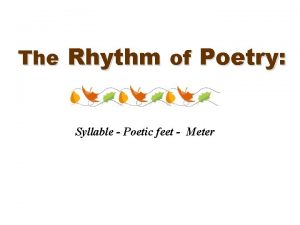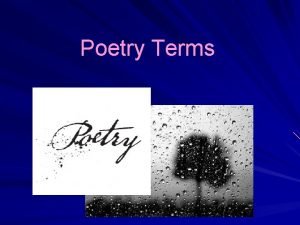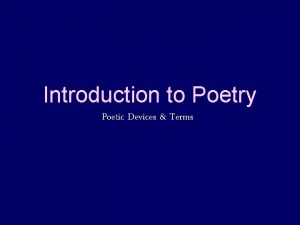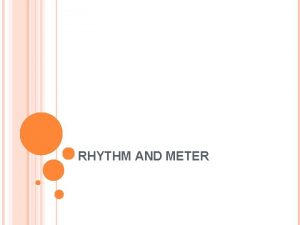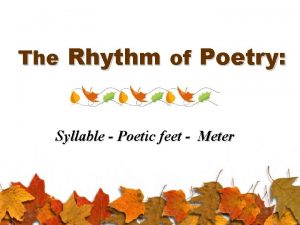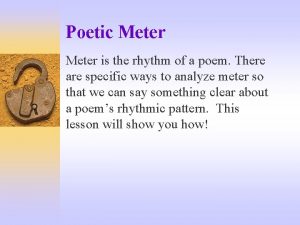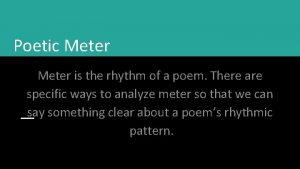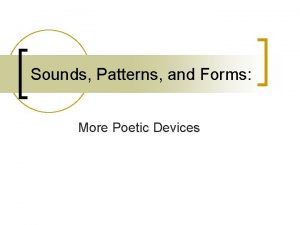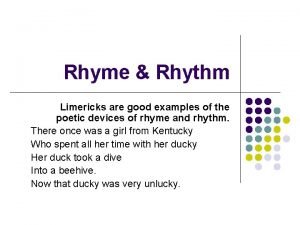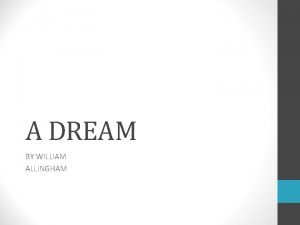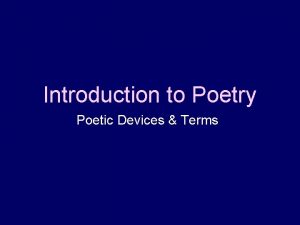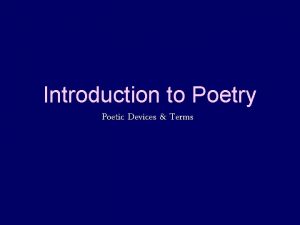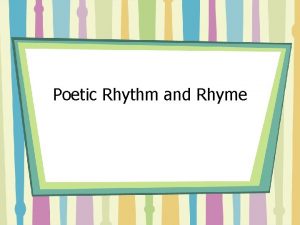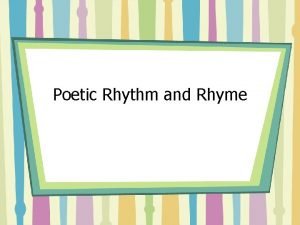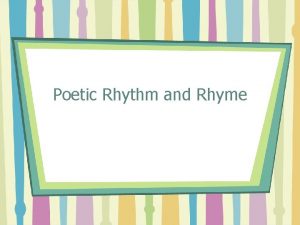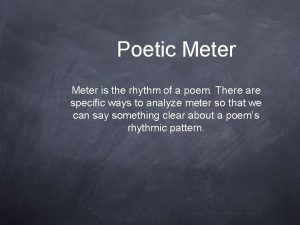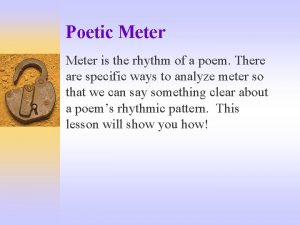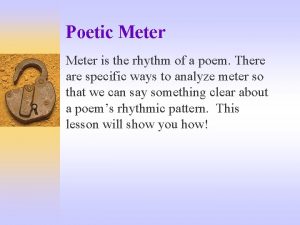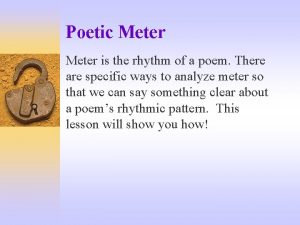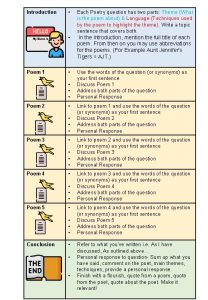Poetic Meter is the rhythm of a poem












- Slides: 12

Poetic Meter is the rhythm of a poem. There are specific ways to analyze meter so that we can say something clear about a poem’s rhythmic pattern.

Let’s Look At a Poem

To “scan” a poem, we mark each stressed and each unstressed syllable with a mark. Here, we’ll use / for stressed and ~ for unstressed. • ~ / ~ / ~ / • Aunt Jennifer’s tigers prance across the screen • ~ / ~ / ~ / • Bright topaz denizens of a world of green. • Then we count the stressed syllables in a single line. Here there are 5 stressed syllables in each line.

Counting Stressed Syllables • Once we have taken a count of the stressed syllables in each line, we have a good idea of what the dominant meter of the poem is. Every line may not be the same, but usually there will be one dominant pattern. In Rich’s poem, we could scan all the lines and we would see that there are generally 5 stresses (5 stressed syllables) to each line. • Poetry scansion (scanning a poem) makes use of some Greek-derived words to label the meter of a poem. Let’s take a look at those. • We measure the meter of a poem using the measurement of poetic feet. A foot in poetry is one stressed syllable + the unstressed syllables that seem to go with it.

Poetic Meter • These terms show number of stresses or feet to a line: • One stress (foot) per line = mono + meter = monometer • Two = di + meter = dimeter • Three = tri + meter = trimeter • Four = tetra + meter = tetrameter • Five = penta + meter = pentameter • Six = hexameter hex + a + meter = • Seven = hep + a + meter = • Eight = oct + a + meter = • heptameter octameter Since Rich’s poem has 5 stresses per line, or five poetic feet per line, we can say that its meter is pentameter.

• Finally, we try to determine the dominant type of stressed + unstressed syllable combination which seems prominent throughout the poem. • In Rich’s poem, there are many alternations back and forth between unstressed and stressed syllables. Many look like this: ~ / ~/ ~/

Syllable Patterns • Along with the iamb, there are other possible patterns: • Pattern Noun • ~ / Adjective iambic • ~ ~ / anapestic • /~ trochee trochaic • /~~ dactylic • // spondee spondaic • We describe a poetic line, then, by its type and number of poetic feet. For example: • 5 iambs = iambic pentameter • 4 trochees = trochaic tetrameter

• Iamb = unstressed, stressed To be or not to be, that is the question But soft! What light though yonder window breaks? • Trochee = stressed, unstressed Once upon a midnight dreary Peter, pumpkin-eater Had a wife and couldn’t keep her • Anapest = two unstressed, one stressed The Assyrians came down like a wolf on the fold I am out of humanity’s reach • Dactyl = one stressed, two unstressed Hickory dock, The Mouse ran down the clock • Spondee = two stressed Praise Him

Describing Poetic Meter • About Rich’s poem, “Aunt Jennifer’s Tigers, ” then, we could say that its meter is • iambic pentameter • This tells readers that the dominant meter of the poem is 5 stresses to a line (pentameter) and that the dominant pattern or “foot” of syllable stress is ~ / (iambic).

Common Rhythms • The iamb is very common in the English language: we often speak in iambic pentameter without realizing it: • ~ / ~ / ~ / • I’d like to have you meet a friend of mine. • ~ / ~ / ~ • Did you take out the garbage yesterday? /

Rhythm and Meaning While the iamb ~ / easily represents a natural rhythm and emphasis often used in English, the trochee / ~ gives a feeling of pressing forward, of more urgency or insistence: / ~ / ~ Charging down the King’s path steady On to meet our death charge ready The anapest is used for a galloping kind of rhythm ~~/ or for a light, almost comic feeling: ~ / ~ ~ / There once was a fellow at Drew Who spotted a mouse in his stew, Told the waiter about it, who said “Well don’t shout it” Or the rest will be wanting one too!”

• If the word has only one syllable and it is of great importance to the meaning of the sentence, the word is probably stressed. If the word is not of great importance to the meaning of the sentence, then that single syllable word is probably not stressed. • In addition, rhythm is based on pauses. Know an end-stopped line is one in which the end of the line corresponds with a natural speech pause versus a run-on line where the sense of the line moves on without pause into the next line. Pauses within a line of poetry are called caesuras. • Other key terms to know are free verse , poetry that except for its line arrangement has no regular meter, and blank verse, which is iambic pentameter that is unrhymed. (NOTE: this is the most common meter in English!) • Remember, iambic pentameter is the most common pattern of meter. When you do not have a clue about what metrical pattern the poet is using, count the number of syllables in each line. If the average number of syllables per line is ten, guess iambic pentameter. If the poem was written before the 20 th Century, you will be right at least 90% of the time. If the poem averages eight syllables per line, guess iambic tetrameter. If the lines in a poem vary between six syllables and eight syllables, guess ballad meter (also known as common meter).
 What are poetic feet
What are poetic feet Poetic rhythm definition
Poetic rhythm definition Mood of poems
Mood of poems Sonnet 73 meter
Sonnet 73 meter Example of iambs
Example of iambs Meter definition poetry
Meter definition poetry Common meter in poetry
Common meter in poetry Poetic devices meter
Poetic devices meter Tekanan pada zat padat
Tekanan pada zat padat Examples of end rhyme in the raven
Examples of end rhyme in the raven Which poem has the rhythm of marching
Which poem has the rhythm of marching Poetic techniques repetition
Poetic techniques repetition Shel silverstein noise day
Shel silverstein noise day
